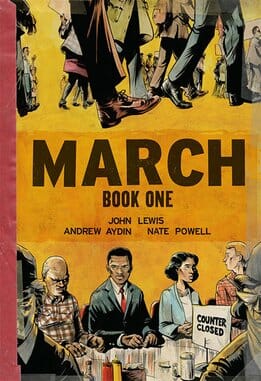March (Book One) by Congressman John Lewis, Andrew Aydin, & Nate Powell

Writer: John Lewis and Andrew Aydin
Artist: Nate Powell
Publisher: Top Shelf
Release Date: August 13, 2013
The first entry in a projected autobiographical trilogy based on the life of Congressman and civil rights leader John Lewis, March almost reads like a sequel to The Silence of Our Friends, one of artist Nate Powell’s most recent projects. With Powell continuing his civil rights-themed work, the artist renders both stories with a great commitment to individuality, balancing the inherent horror and passion with smaller moments that make them feel truer and more relatable.
Lewis’ story flashes back and forth between Inauguration Day 2009 and his childhood through young adulthood. It’s a familiar device when it comes to laying out a biography in a more cinematic, less chronological fashion, but it’s used well by co-scribe Andrew Aydin, who works in Lewis’ D.C. office and makes his debut in the comics field with this work. The wondrousness of Powell’s art is no surprise by now, but the level of the writing is a nice treat. The script isn’t mind-melting or hugely innovative, but it establishes storylines and themes with confidence and easily holds one’s interest. There’s an especially nice moment that implicitly justifies the choice of the comics medium, when we learn that Lewis was inspired by a 1958 comic book about Martin Luther King Jr.
-

-

-

-

-

-

-

-

-

-

-

-

-

-

-

-

-

-

-

-

-

-

-

-

-

-

-

-

-

-

-

-

-

-

-

-

-

-

-

-












































